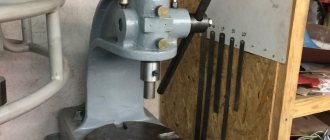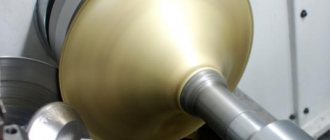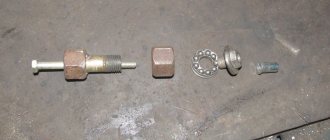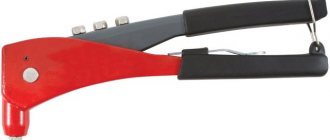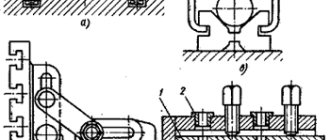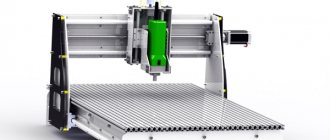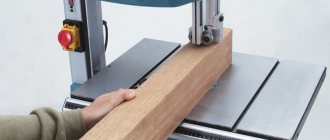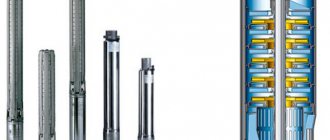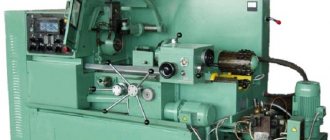- From the network. Not too expensive, so you can buy them for home use. But not every construction site has a source of electricity, and cords/extension cords are a real hassle.
Rechargeable. With the same performance, they are more mobile, but they weigh more (the battery itself also weighs), and they are more expensive. Riveters can be manual, battery-powered, electric, hydraulic
Video review of the MILWAUKEE 2550-20 M12 RIVET TOOL cordless riveter.
For household use, manual riveters are purchased. But even this “simple” tool is not easy to choose. The price range is huge - from $5 to several hundred dollars. How to navigate here? The most reasonable thing would be not to take an expensive one for a one-time job, but also one that is too cheap. The rest needs to be figured out.
What is a manual riveter
Riveters are these types of hand tools that are used to connect two metal workpieces up to 10 mm thick. The main purpose of the tool is to provide a permanent connection of sheet metal. The connection of metal sheets occurs through the through-mounting method. This tool is used when it is impossible to use welding and threaded connectors. Structurally, the tool has the shape of pliers and consists of the following components:
- Handle - sets the mechanism in motion by applying physical force of a person
- Clamping mechanism, which comes in two types - pull-out and threaded
- Head - the fixing part on which the consumable element is attached
This is a simple device that allows you to quickly and permanently connect sheet metal. Riveters are not only manual, but also pneumatic, electric and battery-powered, but the first type of tool is more popular. This is due to a number of advantages, the main ones being affordable price, ease of use and no need to use additional equipment.
Pneumatic, electric and battery-powered devices are more expensive and are intended to be operated by specialists. The main advantage of pneumatic, electric and battery-powered devices is that they do all the work, so the operator does not need to exert any effort. The relevance of their use arises in the case of using large diameter rivets.
This is interesting!
Manual riveters are also called riveters. They come in two types, and to find out what differences they have, let’s look at their parameters.
Top 3 Best Manual Riveters for Steel Rivets
Steel rivets provide the strongest connections between parts. But installing them is not so easy. Not all riveters are designed to work with such pins, but only the strongest and most durable models.
BISON Station wagon 270 mm
You can buy a manual riveter from the best rating if you need a tool for regular and threaded pins with a diameter of 2.4-4.8 mm and M3-M6, respectively. The cast device with a forged handle easily copes with rods made of steel and aluminum, and is characterized by durability and increased strength. The pressure mechanism is wear-resistant, the tool is easy to hold during operation, and your hands do not slip. Included with the rivet gun, the manufacturer offers replaceable tips, for which special niches are provided directly in the body of the device.
The only disadvantages include the need to apply force during the installation of rivets. However, this drawback is common to all conventional manual models.
You can buy a ZUBR Station Wagon from 2800 rubles
Stanley MR55 0-69-804
A steel manual riveter with ergonomic rubberized grips on the handles works with pins 2-5 mm thick. The device comes with replacement tips and a key for replacing them, and there are storage compartments on the device body. The model copes well with aluminum, copper and steel fasteners. Despite the low cost and simplicity of design, it provides a reliable permanent connection.
You can buy a Stanley MR55 from only 800 rubles
Cobalt 243-547
Two-handed riveter with steel body and rubberized handles, suitable for installing aluminum and steel pull pins. Works with diameters of 2.4-4.8 mm, thanks to a well-thought-out lever-folding mechanism and long handles, it ensures ease of installation. Very little physical effort is required. The disadvantages include the lack of a full-fledged transport case and a key for changing attachments in the kit.
The average price of a manual riveter Cobalt 243-547 starts from 900 rubles
Threaded riveter or nut riveter - its pros and cons
This is a special type of riveter, which is designed to work with threaded rivets. This type of tool provides a more reliable connection, and also allows it to be further strengthened through the use of bolts. The threaded connection ends up being permanent. The hole after the connection has an internal thread. The operating principle of threaded riveters is based on the fact that a threaded rivet is screwed onto the tool head (rod or threaded part). After this, a rivet attached to the tool is inserted into the hole, and the handles are compressed. When the handles are compressed, creasing or flaring occurs on the opposite side of the riveting, resulting in the formation of a head.
The design of the threaded riveter is shown in the photo. This type of tool is classified as powerful, and therefore the larger the size of the rivet, the more effort the operator must exert to make the connection. The advantages of such devices include high quality connections, which can be strengthened with a bolted element. In addition, the advantage is the ability to use rivets of different sizes, which also affects the quality of the connection. Such instruments have more disadvantages, and they manifest themselves due to the following factors:
- High cost of the tool: more than 2,500 thousand rubles
- The need to apply great physical effort, which increases depending on the diameter of the riveting
- Low connection speed, since the rivet must first be screwed onto the threaded tip of the tool, and after connection, the device must be unscrewed
- The high cost of not only the tool, but also the rivets
It is rational to choose a threaded riveter only when it is necessary to ensure a reliable connection of sheet steel, as well as in the presence of large diameter holes. The presence of holes at the joints allows the resulting structure to be fastened.
What types of riveters are there?
Riveters for home use can be divided into several categories:
- Power. The tool is activated by pressing the handles and requires physical effort.
Power riveters are the simplest and cheapest - Electrical. They operate by pressing the trigger and have greater productivity. You can use them at home and in the country.
The disadvantage of electric riveters is their dependence on an outlet - Rechargeable. Such models benefit from increased mobility, but at the same time they are characterized by large mass and high cost.
The cordless riveter requires regular recharging. - Pneumatic. The devices work in tandem with a powerful compressor, providing high speed and power.
Pneumatic riveters are more often used in large construction projects.
For home use, people usually buy hand-held tools. If you plan to use the device frequently, you can purchase an automatic model with a battery.
Exhaust view of the riveter - what is it?
This is a tool whose operating principle is similar to threaded ones, only instead of a threaded rod tip, a cylindrical pin is used. These studs are mounted on rivets. The rivet is inserted into the tool hole and then positioned into the pre-drilled hole in the sheet stock. Impact on the tool handles leads to crushing of the rivet on the reverse side by pulling the pin outward. The pin is pulled out and a riveted joint is obtained.
The advantages of exhaust riveters include:
- Low cost, unlike threaded ones
- High speed of work completion
- Easy to install
- It turns out a secret connection
The only disadvantage can be considered that in this way it is impossible to connect sheet steel in which large-diameter holes are made. Such tools are intended for joining sheet metal with hole diameters up to 7 mm.
Pull riveter: basic information
The principle of operation is almost the same as that of the threaded one. But the working part is a cylindrical pin. The pin is installed on a rivet, which is placed in the hole of the tool and then into the hole prepared in the workpiece. When the handles are moved, the rivet is crushed on the reverse side by the pin coming out. After removing the pin, a connected structure is obtained.
The positive characteristics of the model include:
- A simple diagram for installing fasteners.
- High performance.
- Possibility of creating a hidden fastening.
- The price is lower than analogues.
The disadvantage is that it is impossible to connect sheet material in which large holes are made - more than 7.0 mm.
Most importantly, these parts are divided into two more subtypes: nut and pull-out. The latter contain two parts: a tube and an interior, the so-called poisson or rod.
How does a riveter work?
A construction worker or a person involved in the loading and unloading of large metal structures and materials knows the answer to this question.
And for all other people interested in the mechanism of operation of this tool, the explanation is given below.
How the tool works
A riveter is a mechanical tool that allows you to quickly and accurately fasten together sheets of metal, the thickness of which is three millimeters.
With the same ease, it connects the profile and the corner with each other.
In order to carry out the riveting process, it is necessary to first do preparatory work.
Namely: drill a hole at the intended connection location.
Next, a rivet blank, previously inserted into the rivet gun, is inserted into the hole.
In this case, both ends of this workpiece must protrude from the planes or parts being fastened. When the handle of the tool is pressed repeatedly, a gradual flattening of this part occurs.
When its upper part is flattened as much as possible, the fastening on one side will already hold firmly, resting on the “thick” part.
After the riveting process is completed, the lower “tail” of the rivet part is bitten off with a special tool. You must always take into account the thickness of the parts being fastened. They need to choose the appropriate fastening size. For example, for metal sheets with thickness:
- Up to half a millimeter must be riveted with rivets with a size of 2.4 mm.
- Nine and a half centimeters – 3.2 mm.
- Twelve and a half millimeters - from 4 mm to 4.8 mm.
In this case, the hole for each rivet of different sizes must be drilled one millimeter larger than the diameter of the rivet. Accordingly, for a part with a width of 2.4 mm, a hole will be made two and a half millimeters thick, 3.2 mm - 3.3 mm, for 4 mm - 4.1 mm, for 4.8 mm - 4.9 mm .
The strength of a rivet of any size is determined not by its size, but by the quality of the metal, and the power of the resistance provided by the structural elements that were made with the help of rivets. If such pressure is high, the metal rivet gradually softens or deforms.
The operation of the tool is based on the effect of flattening the metal due to targeted pressure on a certain part of the piece (workpiece).
Rivets and working with them
An explanation of how a manual riveter works cannot be complete without considering the types of riveting tools (consumables - rivets).
There are two fundamental types of these parts: monolithic, that is, solid, and tubular.
The latter are usually called pistons.
Solid metal rivets are more like just a piece of thick wire and are used only for the hand-made type of riveting.
Much later than the beginning of the use of the described type, the now more commonly used pistons appeared - the second type (inside there is soft metal that is quite easily flattened when pressed).
Most importantly, these parts are divided into two more subtypes: nut and pull-out. The latter contain two parts: a tube and an interior, the so-called poisson or rod.
On top of such a simple design there is an enlarged part - a cap, which prevents the rivet from prematurely protruding or breaking. The poisson is inserted from the reverse side, that is, from the opposite side - where the head is located.
It turns out that rivets are inserted on both sides, subsequently flattened.
Riveters for threaded rivets
How does a riveter for threaded rivets work?
The principle is the same, but the peculiarity of the rivet material is that, after being screwed (hammered) into the structure, it is bitten off with a special construction tool.
And besides, you can choose any length this way.
If it comes to large volumes of rivet work, you need to take the so-called professional mechanism, which allows you to make a larger number of rivets with less effort.
A slightly more complex mechanism (besides the manual one) is called a pneumatic riveter. It works using compressed air.
Pneumatic devices require the use of a compressor. There are professional mechanisms that contain a hydraulic press in their design.
This type of riveter is called pneumohydraulic. As can be seen from the definition, it works thanks to two types of mechanisms that drive the main working element.
To select a tool for making a clear rivet joint between metal parts, including sheet metal and profiles, you need to take into account the thickness of the material being fastened.
More details about the pneumohydraulic riveter are presented in the video:
Noticed a mistake? Select it and press Ctrl+Enter to let us know.
A riveter is a tool designed for installing blind rivets. This is a fairly simple and reliable device. The connection created with its help is highly durable and resistant to vibration. In terms of strength, such fastening can be equated to spot welding. At the same time, riveters make it possible to connect various sheet materials, including plywood, and not just steel.
A riveter is a tool designed for installing blind rivets. This is a fairly simple and reliable device. The connection created with its help is highly durable and resistant to vibration. In terms of strength, such fastening can be equated to spot welding. At the same time, riveters make it possible to connect various sheet materials, including plywood, and not just steel.
How to use a riveter
Types of riveters
Although this tool has a very simple design, its implementation is still possible in various ways. Thanks to this, 4 types of riveters were developed:
- Mechanical.
- Electrical.
- Pneumatic.
- Hydraulic.
Mechanical
Mechanical devices in a reinforced two-handed version
They allow you to work with thicker rivets. If a one-handed tool is capable of tightening fasteners with a diameter of up to 4.9 mm, then a two-handed tool works with a thickness of 6.5 mm.
Electrical
Not long ago, electric riveters received a worthy competitor. A special attachment for a screwdriver works just as effectively and is cheaper. If the electric riveter itself can only work with fasteners, then buying a screwdriver is more profitable. You can put in it not only a rivet attachment, but also a drill or a bit for screws.
The electric riveter still has one advantage over the nozzle. Its design provides a special container for collecting torn tails from rivets. They do not need to be removed from the gun manually, which ensures high labor speed. In addition, they do not fall on the floor or ground, which eliminates the need for cleaning. Not every electric riveter has the function of collecting rods. Many, even expensive branded ones, do not have such a useful extension.
Pneumatic riveter
Pneumatic devices are very productive. Their mechanism ensures tightening when exposed to compressed air supplied from the compressor receiver. Working with such equipment is a pleasure, but there are some inconveniences. First of all, this concerns the need to use a compressor. A rather thick hose stretches from it, which hinders movement. In addition, the operating noise of the compressor can hardly be called quiet, and the rather short hose does not allow it to be placed far away.
Typically, pneumatic riveters are used in production. They are connected to a common compressed air supply line that runs throughout the workshop. At the same time, the noisy compressor is located far away. The quality of connections made by pneumatic tools is very high, which is why they are used to assemble interior parts of cars, buses, railway cars and other structures.
Hydraulic
Externally, such a tool looks like a pneumatic screwdriver. At the bottom of the riveter there is a reservoir with hydraulic fluid. The device is connected to a conventional compressor, like classic pneumatic devices. The supplied compressed air leads to the movement of hydraulic fluid, which triggers the mechanism for tightening and then unscrewing the stud.
When using a pneumatic-hydraulic riveter, you should pay attention to the settings. This tool requires precise adjustment. If the rod is set incorrectly, the device begins turning out the stud before the threaded sleeve reaches sufficient deformation.
Tips for using riveters
When using the tool, you need to pick up fallen rivet rods, since at the point of breakage they acquire a rather sharp edge, which often digs into tires. It can also get caught in shoes and cause injury. Some rivets have steel tails, which can be collected after work using a magnet.
There are cases when, after reaching a sufficient level of deformation of the fastener sleeve, the tool cannot pull out its rod. If this happens, you can break it manually or bite off the tail with wire cutters.
When choosing a specific model of a hydraulic riveter, it is necessary to take into account the following criteria:
Types of tools by number of handles: one-handed and two-handed
In addition to the fact that riveters come in threaded and pull-out types, they also differ in the number of handles - one-handed and two-handed. A one-handed riveter is considered to be a tool in which one handle is movable and the other is fixed.
These are often exhaust devices that do not require much effort. They are designed for connecting rivets with a diameter of up to 6.4 mm.
Two-handed riveters are devices in which both handles are movable.
These are often threaded-type models, which require a lot of physical effort. They allow for riveted connections using rivets with a diameter of up to 14 mm.
Accordion riveters are a special type of tool that consists of one handle connected to a pressing mechanism in the form of an accordion or toad.
Such a tool also belongs to the category of traction tools, and the design cannot provide high clamping force. Accordion riveters are more expensive than conventional one-handed riveters.
All versions of hand tools are additionally equipped with swivel heads (except for the accordion), which allows riveting connections even in the most difficult to reach places.
The head of such tools has the function of moving up to 360 degrees, which greatly facilitates the use of the tool. However, the cost of such a device is 1.5-2 times higher than a conventional one with a fixed head. For home use, riveters with rotary heads are not needed, so it is not worth spending a lot of money just to have a multi-tool.
This is interesting!
Rotary rivet heads are used by specialists whose work involves the installation of sheet metal, as well as in the manufacture of structures, for example, mailboxes, etc.
Selection of riveter
When choosing a riveter, it is not least worth focusing on the power control method incorporated into it. For example, two-handed models will provide greater pressure, which will allow you to work with a wider range of materials. The rotatable head reaches places where other models cannot. The owner is recommended to pay attention to the product package: it should include at least a set of heads for each rivet diameter.
This list was compiled based on the opinions of professionals and the opinions of ordinary buyers. The article will help the reader decide on the choice of tool based on his needs and preferences. The market for instruments of this class is replete with the names of manufacturers, but this article lists the most well-known and proven brands.
Kraftool Industry 31178
Metal work. Rotary mechanism. The riveting is highly durable. Works well with threaded type consumables, which allows you to make parts of a prefabricated structure from various metal products. The handle is shaped to most effectively convert effort into quality. Comes with a set of attachments for working with aluminum and other metals. The handle is surrounded by rubber for a firm fit in the hand; special limiting mechanisms help to most conveniently fix the riveter in the working position.
| Weight, kg | 1.8 |
| Length, mm | 360 |
| Width, mm | 190 |
| Height, mm | 55 |
Kraftool Industry 31178
Advantages:
- Durable box included;
- The head makes a full revolution;
- The kit includes keys for the most convenient replacement of nozzles;
- Sturdy body;
- The most important parts are made of steel.
Flaws:
- High price.
Review:
“The purchase did not disappoint. Made well, from strong material. The quality is immediately visible. Supports rivets of any format: from aluminum to steel. There are also any types of rivets: threaded, press-type and others. A professional device, suitable for both domestic and serious work. A definite recommendation!”
COBALT 250 mm 243-561
Supports threaded rivets, cast aluminum body, handles coated with special rubber. Preventing any slipping. The clamping of materials is reliable, the working range (metals that are feasible for the tool) is wide. Nozzles of all diameters are included in the kit. The length of the rivets can be up to 250mm. The pressing mechanisms are very durable in themselves, which allows you to avoid replacing them over a long period.
| Weight, kg | 0.84 |
| Length, mm | 340 |
| Width, mm | 185 |
| Height, mm | 40 |
COBALT 250 mm 243-561
Advantages:
- Reliable push mechanism;
- Comfortable handle;
- Rivets up to 250mm are supported.
Flaws:
- Not found.
Review:
“I don’t have much experience working with tools of this kind. This is my first riveter. I bought it to work with M5 rivets. Cobalt turned out to be a very durable and well-thought-out device: when the rivet is fixed, you do not need to unscrew the entire rivet holder from it, only the working part. The shape of the handles is made so that the brushes do not hurt, even after prolonged use, this is a clear plus for the manufacturer. My impressions of Cobalt are purely positive, so I can give a strong recommendation for purchase! “
Kraftool 31161
The lever riveter is designed for high loads. The handle is equipped with a special limiter and surrounded by rubber of a complex composition for a firm fit in the hand. The advantage of this model is that the user can staple from the end, rather than from both sides. The pressing mechanism is designed in such a way that only a small amount of effort is required to achieve a reliable clip. The body is cast from aluminum, which ensures long service life for the instrument.
| Weight, kg | 0.76 |
| Length, mm | 290 |
| Width, mm | 140 |
| Height, mm | 43 |
Kraftool 31161
Advantages:
- Cast body;
- End staple system;
- High loads supported.
Flaws:
- The size of the model does not allow working in hard-to-reach places.
Review:
“I bought it for work in a private house. It showed its best side, although from personal observation, the container could have been arranged more comfortably. Otherwise, the tool is excellent; the ability to mount it from the end makes it indispensable for household work. I recommend purchasing!”
MATRIX 40533
Advanced riveter with rotating mechanism. Designed for fastening thin materials. Thanks to the mechanism that ensures full rotation of the working head, the tool can work in any place. The steel body can withstand increased loads very well. Long service life. Equipped with a locking element for convenient storage. Comes with all necessary replacement elements.
| Weight, kg | 0.73 |
| Length, mm | 355 |
| Width, mm | 130 |
| Height, mm | 28 |
MATRIX 40533
Advantages:
- Swivel mechanism;
- Affordable price tag;
- Comfortable handle;
Flaws:
- Some rivet formats require more force.
Review:
“I finally bought a riveter. Since this is my first one, I had to rely on reviews from the Internet. There were many positive reviews about Matrix 40533, so the choice fell on this model. An excellent device that allows you to switch from screw connections to rivet fastening with maximum pleasure! The 360-degree rotating head allows you to work from any position - it’s very convenient. The tool deserves a recommendation!”
MATRIX PROFESSIONAL 40535
Professional segment tool for fastening metal materials. It is equipped with all formats of nozzles, as well as a key for the most comfortable changing of them. The body is cast, which guarantees long-term operation without problems, the working area is equipped with an improved mechanism. The container allows you to quickly collect consumables without scattering them around the workplace. The handles are surrounded by special plastic so that the tool sits firmly in the hand.
| Weight, kg | 2.03 |
| Length, mm | 540 |
| Width, mm | 175 |
| Height, mm | 45 |
MATRIX PROFESSIONAL 40535
Advantages:
- Improved workspace;
- Container for collecting consumables;
- Price.
Flaws:
- Not found.
Review:
“I purchased this model to replace an old riveter. The previous tool was from the cheap segment. He didn't grip the rivets well, and the paperclip was even worse. We had to make great efforts to achieve at least some result. The Matrix 40535 model pleased me. Compared to the old one, it definitely wins. The rivet gripping mechanism works perfectly; no effort is needed to achieve a high-quality clip; everything is done in a playful manner. The word Professional in the name is definitely justified! I recommend buying!”
Topex 43e791
This model specializes in drywall. Available dowel formats are 3-6 mm. The body is cast monolithically, steel. Plastic lining will provide comfort when working. The developer assumed that this tool would be used by amateurs, so he made it as simple and understandable as possible. Even those owners who have no experience in construction can cope with it. The attachments are changed very easily using the key included in the kit.
| Weight, kg | 1 |
| Length, mm | 250 |
| Width, mm | 180 |
| Height, mm | 35 |
Topex 43e791
Advantages:
- Ease of use;
- Price;
Flaws:
- Limited range of possibilities.
Review:
“I have no experience in finishing. It is for this reason that I purchased this riveter. I would like to say that he copes with his direct responsibilities with a bang - the work on drywall is carried out easily and simply. It is unlikely to be suitable for more severe conditions. I can recommend this model to an amateur like me, but professionals would be better off choosing something more serious.”
End riveter NEO (for rivets 18-107)
Professional-grade tool for joining solid objects: metal sheets, building materials, hard plastic products. Acceptable rivet sizes are from 2.4 mm to 4.8. The work takes place on the principle of a lever, so you don’t need to put in much effort. The body is strong and made of metal, the handle is made so that it is comfortable to work even for a long time.
| Weight, kg | 0.75 |
| Length, mm | 150 |
| Width, mm | 50 |
| Height, mm | 30 |
End riveter NEO (for rivets 18-107)
Advantages:
- High-quality assembly;
- Consumables are presented in full;
- Works well even with large format rivets.
Flaws:
- The container could have been made larger.
Review:
“I bought a device for working with gypsum sheets. He coped with this task perfectly, which is not surprising, because he is focused on working with metals, and for him drywall is just a joke. I am not a professional, but nevertheless, there were no problems with the operation of NEO. The device is expensive, but reliable and provides clear results. I can recommend NEO to anyone who doesn’t mind spending money on a good instrument!”
Delo Techniki 456163
The device is popular among professionals. Provides quality fastening of hard materials using hidden rivets. The handles of the tool are rubberized, which allows you not to worry about grip strength during the working process. The nozzle replacement mechanism does not require third-party master keys - the user can easily do it with his own hands. Equipped with an element that fixes the handles when not in use. This allows you to neatly store the tool when not needed.
| Weight, kg | 1.5 |
| Length, mm | 220 |
| Width, mm | 140 |
| Height, mm | 40 |
Delo Techniki 456163
Advantages:
- Ergonomic shape allows you to work in hard-to-reach places;
- A set of attachments in a separate oiled case;
- Affordable price for a device of this class.
Flaws:
- Some stave formats will require significant effort;
Review:
“A good device, but strictly for professional purposes. I wouldn’t recommend it to home craftsmen - they simply don’t need it, it’s better to choose a simpler model. And for those whose work is closely related to fastening solid materials, this riveter will be very useful. Yes, its shape is such that some consumables will require effort to fix, but that’s why it’s a tool for the professional segment.”
Gesipa 7010001
The Flipper model is made for a wide range of jobs. Rivet formats are supported up to 5 mm. A special compartment is designed to store the key and consumables. The handle is rubberized, so Gesipa Flipper will be firmly fixed in your hand. The working amplitude during operation is large, allowing you to work even with very long rivets. The pressing mechanism has been improved, the user can carry out full operation with one hand.
| Weight, kg | 0.86 |
| Length, mm | 219 |
| Width, mm | 201 |
| Height, mm | 36 |
Gesipa 7010001
Advantages:
- Ability to work with one hand;
- Compartment for storing the key and collecting consumables;
- Ability to work with long rivets.
Flaws:
- Not found.
Review:
“I recommend purchasing to those who do not have professional skills in working with metals and other hard materials. An excellent tool, ergonomic, allows you to reach the most inaccessible areas and clip there. For the money, the device definitely deserves attention. I recommend buying!”
FIT 32058
Riveter for working in hard-to-reach areas. Supports blind rivets up to 6.4mm in size. The tool has two handles, the pressing mechanism is well adjusted, so it is convenient to work with it. The steel body guarantees trouble-free operation over a long period of time. Can work with high loads.
| Weight, kg | 1.44 |
| Length, mm | 466 |
| Width, mm | 181 |
| Height, mm | 48 |
FIT 32058
Advantages:
- Durable housing;
- Adjustable riveting grip;
- Complete set with attachments.
Flaws:
- Price.
Review:
“The purchase of a riveter was prompted by defects in the old car. Since I had not worked with tools of this class before, I had to trust the opinions on the Internet. And they didn't let me down! The FIT 32058 device turned out to be an excellent assistant in the fight against car defects, I recommend it for purchase!”
JTC 1-5218N
A manual riveter, designed for minor work, such as quick repairs to car upholstery. The developer made sure that the tool was understandable to an amateur who had never dealt with metal work. It is intuitive, so it can be recommended to any home craftsman. It works on the principle of a lever: the user presses the handle, the tool clips the materials.
| Weight, kg | 1.36 |
| Length, mm | 140 |
| Width, mm | 330 |
| Height, mm | 40 |
JTC 1-5218N
Advantages:
- Mobility;
- Easy to use;
- Price.
Flaws:
- Narrow range of possibilities.
Review:
“I bought this model for small household jobs, like fastening the trim of a car. He copes with these tasks flawlessly. At this price, I can recommend it to everyone, if only to have a riveter in your toolkit just in case.”
What types of rivets are available?
The riveting method does not lose popularity, even despite the availability of different welding equipment. Not all materials can be welded, so the use of rivets has been and will always be relevant. Depending on the tool used, rivets or also called bosses are classified into the following types:
- Ordinary or classic - this is the simplest type of rivets, which have the shape of a fungus.
Designed for riveting two or more sheets of steel without the use of specialized tools. The principle of operation of such rivets is that the connection is made by crushing the head of the boss with a hammer - Semi-tubular - they look like a half-hollow rod.
The advantage of such equipment is that they do not require much effort to connect, but they have low strength, which is their disadvantage. They are usually used where there are small mechanical loads - Exhaust - they are also called embedded, tear-off and traction.
They are used in conjunction with blind riveters, and are often used not only for joining galvanized sheets, but also when installing fences made of corrugated sheets - Piston - used to ensure the connection of two parts where there is little or no load.
Commonly used on clothing as a decorative material - Threaded - they are also called nuts.
They are also intended for use in conjunction with a specialized tool - a thread riveter. This is the most reliable type of riveted connector
All types of rivets are used in different fields - mechanical engineering, auto repair, construction, manufacturing of sheet steel structures, tinsmiths, etc. Depending on the type of riveter, it is necessary to select the appropriate bosses. If you need to make a one-time connection using the riveting method, you will not need to buy a special tool. For this, classic rivets are used.
When choosing, you need to take into account that rivets come in different diameters, which affects the quality of the connection. Tie rivets are available in the following sizes:
- 2.4 mm
- 3 mm
- 3.2 mm
- 4 mm
- 4.8 mm
- 5 mm
- 6 mm
- 6.4 mm
Threaded rivets are also available in different sizes:
- M3
- M4
- M6
- M8
- M10
- M12
- M14
The larger the size of the rivet, the higher its cost, and, accordingly, the stronger the connection.
This is interesting!
Materials used to make rivets include aluminum, stainless steel, brass, copper and even steel.
What are there and how to choose rivets for a riveter
There are several types of rivet fasteners according to their design:
- solid, consist of a cylindrical rod and head;
- exhaust hoods, in addition to the rod, are equipped with a sleeve that is crushed during installation;
- threaded, made in the form of a sleeve with an internal thread, along which the rod is first twisted and then pulled out, forming a rivet.
It is also customary to distinguish types of pins by material. For example:
- aluminum;
- copper;
- steel;
- bronze;
- brass.
When choosing rivets, you need to take into account the specifics of the work. The strongest connections are provided by solid or threaded steel elements. Combined fasteners with the addition of aluminum are also popular. But in the latter case, preference should be given to AlMg3.5% alloy; it is resistant to loads and is used even when installing facades.
The most popular are blind rivets, simple but reliable. Tip! When purchasing rivets, you should take into account the thickness of the materials being fastened and select the length of the rods in accordance with it.
Riveter operating principle of the tool
The operating principle of all types of devices is the same, but there are some differences. If you are using a manual riveter for the first time, it will be useful to learn about how it works.
The main operating principle of a manual riveter is based on the transmission of force from the lever mechanism to the head. To begin with, a consumable element is inserted into a pre-prepared hole. To ensure compression of the rivet, a compression mechanism is used, through which deformation occurs. As a result, the consumable element, due to the protrusions (skirts), ensures a reliable connection of the sheet material. How different types of riveters work, we will consider in detail below.
Rating of the best thread riveters
Since threaded rivets are considered one of the most reliable, tools for their installation are in particular demand. Among the popular models there are both expensive and budget riveters.
Kraftool Industry 31178
A threaded riveter with a rotating mechanism is capable of working with any metal workpiece. It comes with attachments for aluminum pins, pluses include a rubberized handle and the presence of stops for fixing the tool in the desired position.
The average price of Kraftool Industrie is about 3,600 rubles
Cobalt 243-561
A manual riveter in a cast aluminum housing ensures reliable fastening with threaded elements. Works with rods up to 250 mm, the kit includes attachments of all popular diameters. The handles of the tool are rubberized to prevent your hands from slipping, the pressure mechanism is highly durable and does not fail for a long time.
You can buy a Cobalt riveter from 2,200 rubles
JTC-5218N
Compact threading tool suitable for setting rivets in metal structures. It is used for joining sheet parts and thin profiles; it is in demand in automotive repair and construction. It has a reliable lever mechanism, the tool handles are rubberized for user comfort, fingers do not slip off. Supplied complete with replacement tips and a key for their installation.
The average price of JTC-5218N starts from 3,000 rubles
Threaded riveter, principle of its operation, step-by-step instructions
The most reliable connection is ensured using threaded devices. The principle of their operation is quite simple, but it causes some inconvenience - each rivet must be screwed onto the end of the tool before use. The instructions on how threaded devices work are as follows:
- Initially, it is necessary to drill a hole of the appropriate diameter in sheet steel - from 3 to 14 mm or M3-M14
- Install a threaded tip (rod) into the tool head of the appropriate diameter.
- Screw the threaded boss onto the tip until it stops.
- Install the rivet into the holes of the elements to be connected
- Perform riveting by acting on the levers (bringing them together)
- Next, to disconnect the tool from the resulting connection, you will need to unscrew it
- After this, the connection is ready for use, and a bolt of the appropriate diameter can be screwed into it
For clarity, below is a video that shows what a threaded tool is and how it is used.
Purpose and principle of operation of the rivet gun
The riveter is used to connect flat workpieces together, where the width of the contact points exceeds their thickness by 3 or more times.
For example, if you fold two identical strips of steel with dimensions 4x40 mm close together, their width will exceed the total thickness by 5 times.
In this case, the use of rivets as connecting elements is justified.
Riveting pliers, as riveters are otherwise called, are suitable for connecting parts with a total thickness of no more than 13 mm.
The tool is used in everyday life, in production, in construction and is indispensable in various repair shops.
A mechanical riveter is shaped like large pliers, and the principle of its operation is to transfer force from the handles - levers to the working mechanism, which installs the rivet element in the hole.
The fastening element itself consists of the following parts:
- A rivet is a tube with a cap located on one side.
- The core is a steel rod originally located inside the stave. It has an extension at its end.
As it works, the tool pulls the rod through the stave, expanding its tube.
At the moment when the force reaches a given value, the rod simply bites off.
The elementary principle of operation is what determines the high popularity of the riveter in the formation of strong joints.
Riveter accordion toad principle of its use
The principle of operation of the accordion riveter is quite simple and uncomplicated. When using it, it is important to consider that there must be enough free space for riveting. The length of the tool in the extended position reaches 80 cm. The principle of using the tool is as follows:
- First you need to install the rivet into the device with the pin inward.
- Fully release the handle
- Install the rivet into the hole
- Compress the accordion-shaped mechanism
- Remove the remaining pin from the tool chuck
Detailed video description below.
The advantage of the toad is that the operator needs to exert less effort than when working with a tool that has one movable and fixed handle.
How to use a regular riveter - rules and recommendations
If you have an ordinary model of a riveter, then the instructions for using it are identical to using an accordion tool. A rivet is installed in the hole of the tool, having previously selected the required cartridge (depending on the size of the stud). Afterwards, the boss fixed in the gun cartridge is compacted into the preliminary hole of two sheet materials. By acting on the handle, the wall of the boss is compressed by pulling out the inner pin with the tip. The wall on the reverse side is flattened, thereby making a reliable connection. If protruding parts of the boss remain, they can be removed with pliers.
A diagram of the operating principle of a manual riveter is shown in the photo below.
Experts recommend a clear approach to the choice of rivets. The effectiveness of the connection depends on their choice. If the length of the boss is less than the thickness of the workpieces to be joined, then in the end the connection will not work. The length of the boss itself should be 2 times the thickness of the parts being connected, but no more.
Operating principle of pneumatic riveters
When performing riveting work, depending on the type of riveter, the rivet rod is fixed in the tool or the rivet maker rod is screwed into a threaded rivet. After pressing the trigger, the rivet is installed under the influence of compressed air.
Types of pneumatic riveters
Modern manufacturers offer pneumatic riveting tools for various purposes and performance.
Depending on the purpose, there are two main types of pneumohydraulic riveters:
- For installation of blind rivets;
- For installation of threaded (nut) rivets.
In addition, different types of pneumatic riveters differ in technical characteristics - created by the working stroke and thrust, as well as the presence of nozzles for working with rivets of different diameters.
Before using the riveter itself, it is necessary to drill holes on the parts into which the rivet will be inserted. The holes should be through and slightly larger than the diameter of the rivets.
How to choose a quality device
Why does the question of how to choose a riveter remain relevant? After all, despite the fact that the tool belongs to the manual category, it has a fairly high cost. To save money, many buyers decide to take a desperate step - they choose cheap models. As a result, the device fails very quickly, and it turns out that the money was wasted. You should also not buy expensive models, since it turns out that the tool will simply lie on a shelf in the garage most of the time. What to consider when choosing a manual riveter - there are the following nuances:
- Device body material - do not buy plastic models.
No matter how colorfully manufacturers and sellers describe them, such instruments are toys that are only suitable for children. You need to choose devices only from high-quality steel. Reputable manufacturers indicate the type of steel used in the technical description - How much does the tool weigh? A good thread riveter has an appropriate weight, which allows it to be used for connecting rivets with a diameter of 12-14 mm
- Equipment - usually good and high-quality devices are sold complete with replaceable heads, as well as consumables.
In addition, the devices are located in special plastic, metal or wooden cases, which simplifies not only their storage, but also transportation - The manufacturer is very important, since today different manufacturers with unknown reputations appear on the market.
It is not recommended to tempt fate, so choose riveters from manufacturers such as Kraftool, Matrix, Gross, JTC, Stayer and others
This is interesting!
If you plan to use the tool frequently, then preference should be given to reinforced riveters.
They are more expensive than regular ones, but last longer and are designed specifically for long-term use. Drawing a conclusion about what types of manual riveters there are, it must be said that tie-type models are quite sufficient for home use. A threaded tool can also come in handy, but only if you plan to work with sheet steel. Proper storage and use will increase the service life of even a budget tool model.

